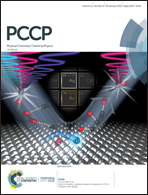Dissociative photodetachment vs. photodissociation of aromatic carboxylates: the benzoate and naphthoate anions†
Abstract
The competition between dissociative photodetachment and photodissociation of cold benzoate and naphthoate anions was studied through measurement of the kinetic energy of the neutral fragments and intact parent benzoyloxy and naphtoyloxy radicals as well as by detecting the anionic fragments whenever they are produced. For the benzoate anion, there is no ionic photodissociation and the radical dissociation occurs near the vertical photodetachment energy. This is in agreement with DFT calculations showing that the dissociation energy in CO2 and C6H5˙ is very low. The dissociation barrier can be deduced from experimental results and calculations to be (0.7 ± 0.1) eV, which makes the benzoyloxyradical C6H5COO˙ very unstable, although more stable than the acetyloxy radical. In the case of naphthoate, the observation of negative fragments at low excitation energies demonstrates the opening of the ionic photodissociation channel in the excited state of the naphthoate anion, whose yield decreases at higher energies when the dissociative photodetachment channel opens.



 Please wait while we load your content...
Please wait while we load your content...